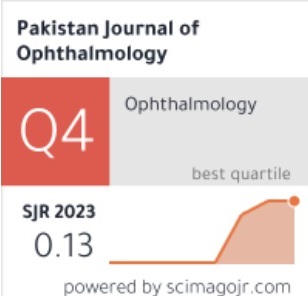Computer Vision Syndrome (CVS) and its Associated Risk Factors among Undergraduate Medical Students in Midst of COVID-19
Doi: 10.36351/pjo.v37i1.1124
DOI:
https://doi.org/10.36351/pjo.v37i1.1124Keywords:
COVID-19, Computer Vision Syndrome, Digital eye syndrome, ergonomics, visual display terminals.Abstract
Purpose: To determine the frequency of computer vision syndrome and its associated risk factors among under graduate medical students.
Study Design: Descriptive Cross–sectional study.
Place and Duration of Study: Gujranwala Medical College and Rawalpindi Medical University, Pakistan from 5th August to 28th August, 2020.
Methods: A validated self-designed questionnaire was used for this study. The survey instrument was tailored from a published questionnaire which comprised of questions on demographics, frequency of symptoms of computer vision syndrome, pattern of computer usage and ergonomic practices.
Results: Final analysis was run on 326 under graduate medical students. Females were 228 (69%) and 98 (30%) were males. Age of the participants ranged between 17 to 25 years. Overall frequency of CVS was found to be 98.7%. Twenty nine percent students experienced extra ocular complaints and 71% had ocular symptoms. Symptoms of CVS were more commonly observed among those using desktop/laptop at less than forearm length (p = 0.001). Distance of < 12 inches from mobile phone was found to be associated with eye irritation and neck shoulder pain (p = 0.001). Frequency of break of more than 60 minutes was found to be significantly associated with eye irritation (p = 0.002) and excessive blinking and light sensitivity (p = 0.001). The students not using ergonomically comfortable chair were found to suffer more with symptoms of CVS as compared to those using ergonomically designed chair (p = 0.049).
Conclusion: Health issues related to excessive use of digital devices has become alarmingly high during COVID-19 pandemic. Symptoms of CVS are significantly associated with distance from digital device and less frequent break intervals.
Key Words: COVID-19, Computer Vision Syndrome, Digital eye syndrome, ergonomics, visual display terminals.






